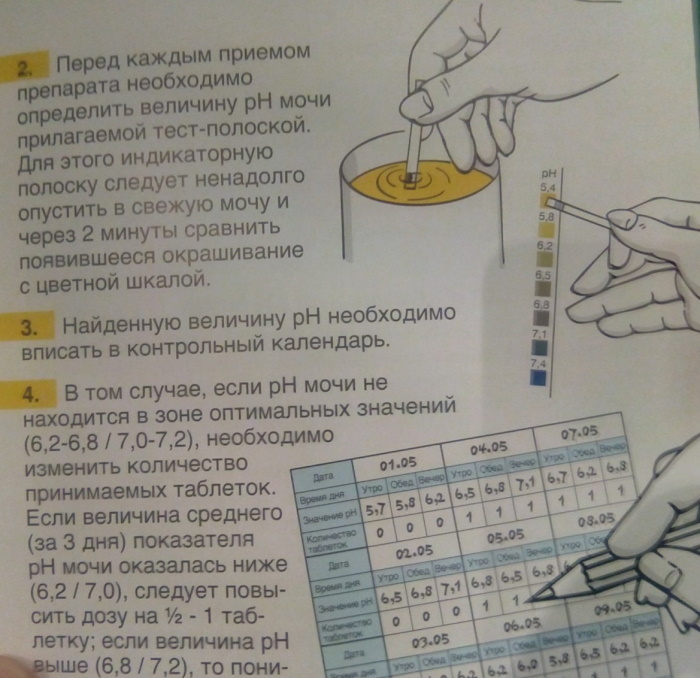Content
- Release form
- Chemical composition
- Pharmacological properties
- Pharmacodynamics and pharmacokinetics
- Indications for use
- Contraindications
- At what age can the drug be used?
- Instructions for use, dosage
- Side effects
- Overdose
- special instructions
- Drug interactions
- List of analogues
- Atropine
- Visin Classic
- Appamide Plus
- Terms, conditions of sale and storage
- The price of the drug and analogues
- Video about phenylephrine drops
Phenylephrine is a medicineused in the treatment and diagnosis of various eye diseases. Drops have a high therapeutic effect and can be prescribed to children. The cost of the product is slightly higher than the average price of similar drugs.
Release form
The medicine is produced in Russia in the form of drops for installations in the conjunctival sac. It is contained in plastic bottles of 5 or 10 ml and packed in cardboard boxes.
Chemical composition
Phenylephrine hydrochloride acts as an active substance.
Additional ingredients:
- disodium salt of ethylenediaminetetraacetic acid;

- benzalkonium chloride;
- sodium hydroxide;
- food additive E330;
- sodium disulfite;
- food additive E331;
- filtered water.
All components combine well with each other and increase the effect of the main substance.
Pharmacological properties
The drug belongs to the class of alpha-adrenergic agonists. When using standard dosages, it does not cause a stimulating effect on the central nervous system.
Topical application leads to pupil dilation, increases the outflow of secretions inside the eye and causes vasoconstriction in the conjunctiva.
The drug affects alpha-adrenergic receptors and weakly affects beta-adrenergic receptors. It has a vasoconstrictor effect. At the same time, the drug has practically no chrono- and inotropic activity.
Vasoconstrictor action occurs in 0.5-1.5 minutes. after using the drug. The action lasts for 2-6 hours. The solution leads to mydriasis within 1 min. after using it. However, it does not cause accommodation.
Pharmacodynamics and pharmacokinetics
The active substance quickly and easily enters the tissues of the eye. The maximum content of the component is noted after 10-20 minutes. after installation.
The drug leaves the body through the renal system in unchanged form or in the form of inactive metabolites.
Indications for use
Phenylephrine - eye drops, the price of which is affordable for most of the population. They are widely used in ophthalmic practice.
Indications:
- inflammation of the anterior part of the choroid (to prevent the formation of complications);
- diagnostics aimed at studying the posterior segment of the eye;
- a study to determine the presence of angle-closure glaucoma;
- studies aimed at determining the differences between eye diseases from other pathologies with similar symptoms;
- preparation for operational actions requiring a state of mydriasis;
- glaucomlecyclical conditions;
- chronic redness of the eyes;
- spasm of accommodation.
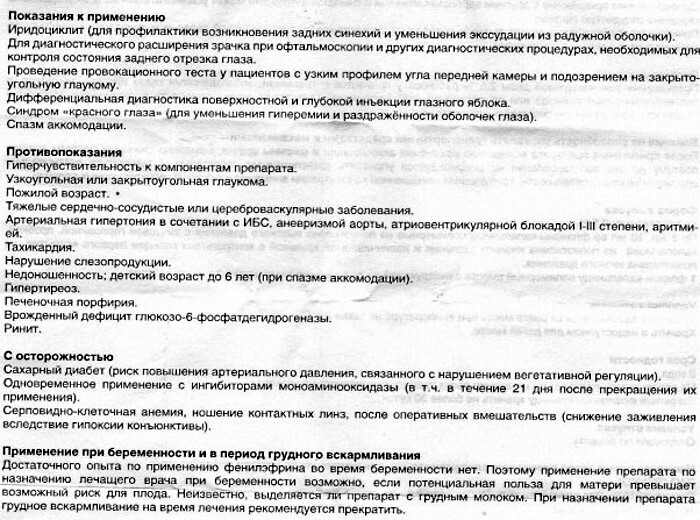
The medicine should be used only in the presence of the listed indications.
Contraindications
The medication has some limitations, in the presence of which the patient may experience complications and other disorders.
Contraindications:
- increased production of thyroid hormones;
- liver porphyria;
- allergy to the composition;
- angle-closure glaucoma;
- arterial aneurysm;
- congenital G6PD deficiency;
- advanced age of patients with disorders of the heart or with circulatory disorders in the brain;
- prematurity;
- re-use during surgery (in patients with damage to the eyeball or in the presence of disorders leading to the production of tear fluid).
Before using the solution, it is recommended to make sure that there is no allergy to its components.
At what age can the drug be used?
Drops can be administered to children. However, the minimum age for a child must be at least 6 years old. In this case, therapy should be monitored by a treating specialist.
Instructions for use, dosage
Phenylephrine - eye drops, the price of which is not a factor that determines their therapeutic effect. They are intended for topical use in ophthalmic practice.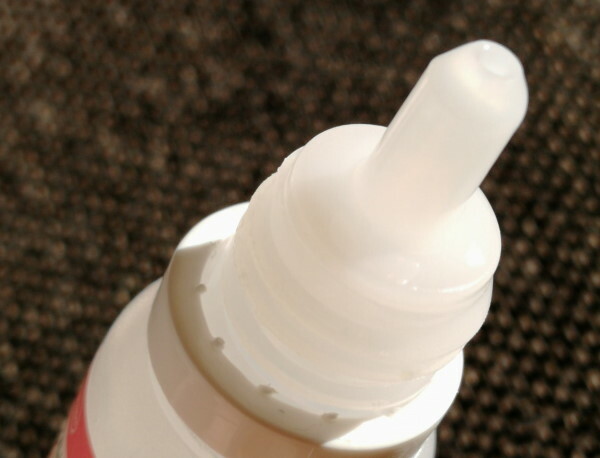
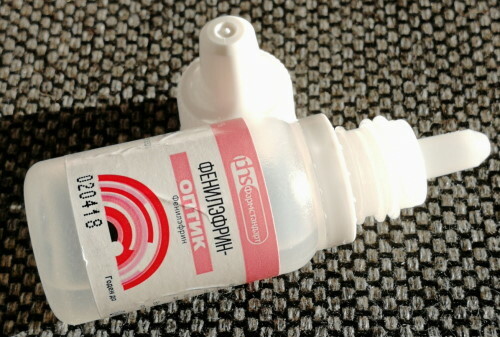
Dosages (for iridocyclitis): 1 drop into the affected eye in the area of the conjunctival sac. Frequency rate of daily use - 2-3 times. Rules for use (for diagnosis): 1 drop of the solution in each eye once. According to the doctor's indications, the medication can be reused after 1 hour. Dosage (for accommodation spasms): 1 drop in the area of each eye. Installations are recommended in the evening before bedtime. The duration of the course is 1 month.
Side effects
In some cases, drops can cause various negative reactions from internal organs and other systems.
Side effects:
- Organs of vision: development of conjunctivitis, blurred vision; swelling, irritation or discomfort in the area of application. Also, at the beginning of therapy, a burning sensation may occur. In some cases, there is increased tearing and an increase in pressure inside the eye. Further after 30-45 minutes. after installations, pigments may appear in the shell. The condition requires differential diagnosis.
- Cardiovascular Disorders: feeling of one's own heartbeat, tachycardia, heart rhythm disturbances, increased blood pressure. Episodes of bradycardia (reflex forms of disorder), pulmonary embolism and occlusive disorders in the coronary arteries may also occur.
- Skin signs: contact form of dermatitis.
In the event of one or more of these symptoms, it is recommended to stop further use of the product and consult a doctor.
Overdose
It is necessary to strictly follow the dosages indicated in the instructions or prescribed by the doctor. Otherwise, the drug can cause negative reactions from various internal organs and systems of a person.
Overdose:
- a feeling of heaviness in the arms, legs, or head;
- tachycardia;
- extrasystolic disorders.
As a therapy, the intake of alpha-blockers is prescribed. In case of violation of heart rhythms, intravenous administration of beta-blockers is indicated.
special instructions
Phenylephrine (the price of the drug does not in any way affect the possibility of developing adverse reactions) is very carefully prescribed to patients with diabetes mellitus, since the use of eye drops in this case can lead to an increase in arterial pressure. This is due to disorders in the autonomic regulatory system.
Also, the drug is prescribed with caution to the elderly, since the risk of developing reactive miosis may increase.
It should be borne in mind that drops can lead to an increase in the absorption of the active ingredient and thereby cause the occurrence of side reactions.
Similar effects can be observed in the following patients:
- damage in the area of the eye and its membranes;
- eye diseases or damage to the appendages of the eye;
- rehabilitation after eye surgery;
- decreased production of tear fluid.
Since the drug can lead to an insufficient supply of oxygen to the conjunctiva, it should be used under the supervision of a specialist in the following cases:
- anemic conditions (sickle-cell form of the disease);
- frequent use of contact lenses;
- rehabilitation after surgical operations.
During pregnancy, as well as during lactation, the drug is used in case of emergency, taking into account the perceived risks and expected benefits.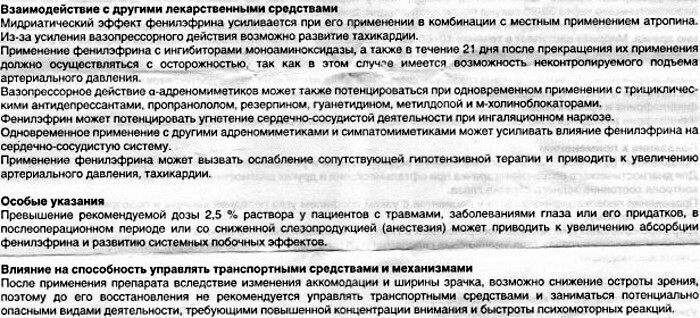
It is required to exercise great care or to give up completely driving a car or carrying out other actions related to increased load on vision or the speed of psychomotor functions. This is due to the fact that at the beginning of treatment, the medication can lead to the development of burning and blurred vision.
Drug interactions
The solution can interact with other drugs.
So mydriatic effect can increase with the simultaneous use of the drug and atropine. At the same time, there is an increase in vasopressor activity, which, in turn, can provoke the development of tachycardia attacks.
It must be remembered that the risks of an increase in blood pressure can be increased with the combination of the medication and MAO inhibitors. This effect is also observed when the solution is used within 3 weeks after the termination of treatment with this group of drugs.
The vasopressor effect of the main drug can increase when it is used simultaneously with the following medications:
- tricyclic antidepressants;
- propranolol;
- m-anticholinergic drugs;
- methyldopa;
- reserpine;
- guanethidine.
Local use of the solution simultaneously with local β-blockers can provoke attacks of acute and rapid increase in blood pressure.
The main remedy can lead to an increased effect of inhalation anesthesia. In this case, a depressing effect on the work of the cardiovascular system is noted.
The combined use of the main medication with sympathomimetic drugs can lead to an increase in the cardiovascular activity of the eye drops.
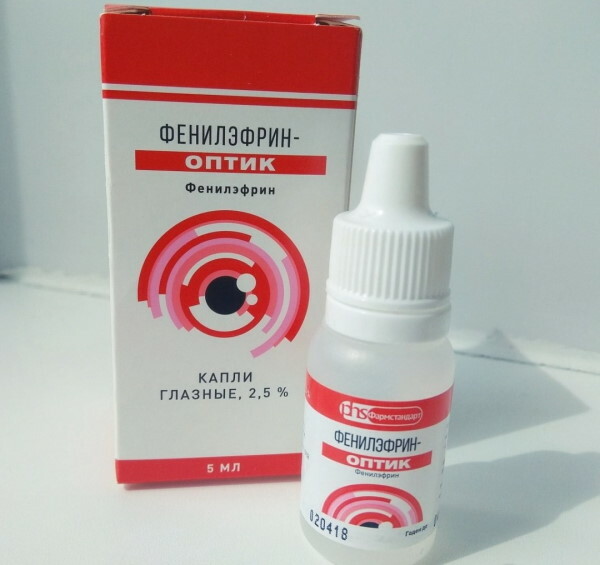
In the case of taking other medications (especially those related to the treatment of eye diseases) during the period of prescribing the main solution, you should first inform the ophthalmologist about this.
List of analogues
Phenylephrine - eye drops, the price of which may vary depending on the concentration of the solution. In some cases, they can be replaced by other drugs similar in action, composition and indications.
Similar funds are used with poor tolerance of the main drug or are prescribed a specialist, taking into account the physiological characteristics of the patient - age, nature and severity of the course disease.
Self-replacement of the solution is not recommended without prior agreement with the ophthalmologist.
All of the generics listed below have an identical active substance, therefore they belong to the group of complete analogs:
- Irifrin.
- Neosinifrin-POS.
- Stelfrin supra.
- Visofrin.
- Midrimax.
- Phenicamide.
Also, the drug has other substitutes with other active ingredients and similar indications.
Atropine
The medication is produced in the form of drops for installations in the eyes. The active ingredient is atropine sulfate.
Drug group - M-anticholinergic (mydriatic).
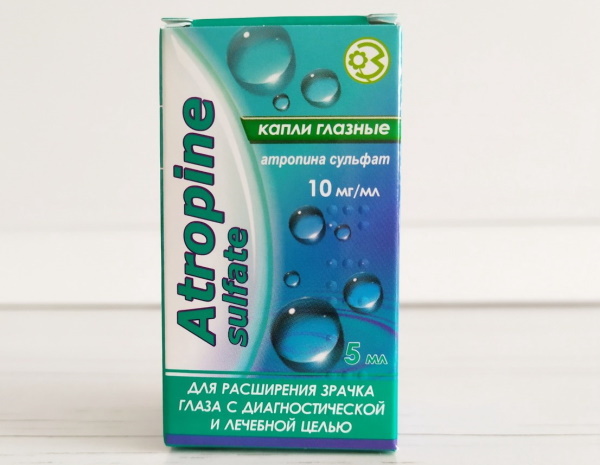
Indications for use:
- refraction diagnostics;
- studying the bottom of the eye;
- trauma to the organs of vision (auxiliary treatment);
- inflammatory pathologies (as adjunctive therapy);
- embolic conditions and spasms that develop in the region of the central retinal artery.
Method of application: 1 drop in each eye up to 3 times a day. In this case, an interval of at least 5-6 hours should be maintained. Duration of use - once before diagnosis or as directed by an ophthalmologist.
Contraindications:
- intolerance to the components;
- children under 7 years old;
- angle-closure glaucoma;
- various types of synechia;
- keratoconus.
It is allowed to use drops during the period of bearing a child. Women during lactation should take into account that the drug is able to penetrate into breast milk. The medicine is subject to prescription. Country of origin - Russia.
Visin Classic
This drug is produced in the form of eye drops, the active substance of which is tetrizoline hydrochloride. Pharmacological group - alpha-adrenergic agonist.
Recommendations for use - puffiness and redness in the conjunctival region of the eye, provoked by the influence of external negative factors or caused by allergies. Scheme of application: 1-2 drops in the area of the affected eye. Installations are carried out 2-3 times a day. The recommended course duration is no more than 4 days.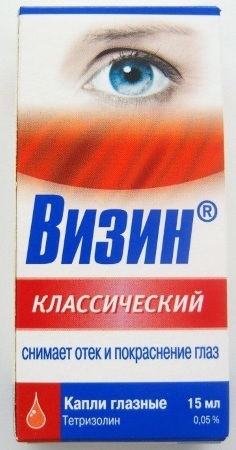
Contraindications:
- allergy to the product;
- dystrophic changes in the stratum corneum;
- angle-closure glaucoma.
With extreme caution and only under the supervision of an ophthalmologist, the medicine can used in the following cases:
- severe pathologies of the heart and cardiovascular system;
- the presence of pheochromocytoma;
- thyrotoxicosis;
- glaucoma;
- hyperplasia of the prostate;
- diabetes;
- porphyrin disease;
- rhinitis (dry manifestation of the disease);
- keratoconjunctivitis (dry form of the disorder).
During the period of gestation and during breastfeeding, it is recommended to refrain from using the solution. Age restrictions - for adults and children over 2 years old. Terms of dispensing - by prescription. Country of issue - USA.
Appamide Plus
Phenylephrine - eye drops, the price of which can differ significantly from the cost of generics. They can be replaced by both full and group analogs.
Generic Appamide is available in the form of eye drops. It belongs to the group of combined products, because it contains 2 active ingredients - phenylephrine and tropicamide. The solution belongs to the class of m-anticholinergics and alpha-adrenergic agents. The indication for prescribing a medication is the need for pupil dilation, which is associated with the diagnosis of eye diseases, as well as with surgical or laser operations.
Dosages: 1-2 drops of the product in each eye for 15-20 minutes. before the start of the procedure.
Restrictions on use:
- allergy to components;
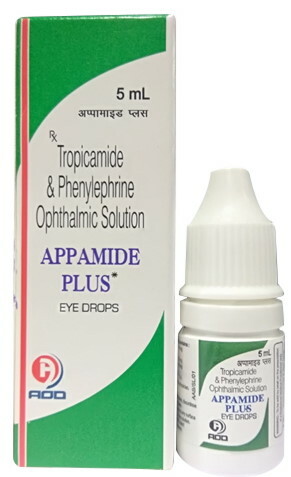
- carrying a child;
- lactation;
- high pressure inside the eye;
- glaucoma (angle-closure form);
- hyperthyroidism;
- various heart diseases;
- type 1 diabetes mellitus.
With extreme caution, the solution is prescribed to the elderly and in type 2 diabetes mellitus. Age restrictions - for adults only. The medication is dispensed by prescription. Manufacturer - India.
Terms, conditions of sale and storage
- Drops should be stored in a dark and dry place at temperatures up to 25 ° C.
- The shelf life is 24 months from the date of issue.
- Do not use after the expiration date indicated on the packaging.
- After removing the protective cover, the solution can be used for the next 1 month.
- The method of sale is prescription.
The price of the drug and analogues
The cost of drugs may differ depending on the region, region and retail pharmacy network.
| Name of the drug | Price |
| Phenylephrine | RUB 300-455 |
| Irifrin | RUB 480-600 |
| Neosinifrin-POS | RUB 300-420 |
| Stelfrin Supra | RUB 310-570 |
| Visofrin | RUB 1115-1250 |
| Midrimax | RUB 400-765 |
| Phenicamide | RUB 595-640 |
| Atropine | RUB 45-60 |
| Visin Classic | 325-400 rub. |
| Appamide Plus | 1240-1990 rub. |
Before using Phenylephrine or other similar drugs, you need to consult your doctor and read the instructions for use. Additionally, it is recommended to study the reviews of those who have already used eye drops. You can check the availability of medicines and find out their exact price at the pharmacy located at the place of residence.
Video about phenylephrine drops
Phenylephrine eye drops:



